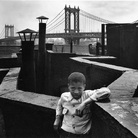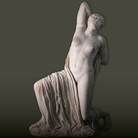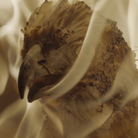The God-Trick

Dal 4 May 2018 al 21 October 2018
Torino
Luogo: PAV - Parco Arte Vivente
Indirizzo: via Giordano Bruno 31
Orari: venerdì ore 15-18; sabato e domenica ore 12-19
Curatori: Marco Scotini
Enti promotori:
- Compagnia di San Paolo
- Fondazione CRT
- Regione Piemonte
- Città di Torino
Costo del biglietto: Biglietto unico valido per l’esposizione permanente e le mostre temporanee: intero euro 4, ridotto euro 3. Gratuito minori di anni 10 e maggiori di anni 65, visitatori diversamente abili e un familiare o altro accompagnatore, un insegnante ogni 15 alunni, dipendenti AMIAT, i possessori dell’Abbonamento Torino Musei / Torino + Piemonte Card, i soci Slow Food, guide turistiche abilitate
Telefono per informazioni: +39 011 3182235
E-Mail info: info@parcoartevivente.it
Sito ufficiale: http://parcoartevivente.it/
Venerdì 4 Maggio alle ore 18.30, il PAV Parco Arte Vivente presenta The God-Trick, mostra collettiva, curata da Marco Scotini, con la quale il Centro intende celebrare i dieci anni d'apertura.
La mostra verrà inaugurata in occasione di un importante convegno internazionale. Attraverso i lavori di artisti che già in passato sono intervenuti nel contesto del PAV, ovvero Lara Almarcegui, Michel Blazy, Critical Art Ensemble, Piero Gilardi, Bonnie Ora Sherk e Nomeda e Gediminas Urbonas, l'obiettivo della mostra quanto del convegno, è quello di affrontare (e ancor più problematizzare) uno dei dibattiti che, negli ultimi anni, si è maggiormente imposto sulla scena internazionale dell'arte contemporanea, ovvero la questione relativa all'Antropocene. Un dibattito pervasivo e corale, che attraversa trasversalmente ogni ambito della conoscenza. Dalla scienza ai cultural studies, dalla filosofia alle pratiche sonore, dalla politica fino alle arti visive, una moltitudine di voci ha creato un complesso reticolato di opinioni, teorie e proposte pragmatiche a partire dall'urgenza imposta dal cambiamento climatico e dalle modifiche ambientali di matrice antropogenica.
Il titolo della mostra prende le mosse da una figura centrale al dibattito come Donna Haraway. Nota ai più come madre del pensiero Cyber femminista, Haraway in più occasioni ha cercato di disarticolare ogni attitudine convenzionale alla lettura dell'Antropocene, arrivando a formulare alternative praticabili e metafore cariche di potere narrativo e generativo. “Non vogliamo teorizzare il mondo, ed ancor meno agire nel mondo, in termini di Sistemi Globali” scrive Haraway. Al contrario, si tratterebbe di sottoporre qualsivoglia pretesa di “oggettivazione” del piano del reale ad un attento e puntuale esercizio di scetticismo, di analisi destrutturante, di dubbio. Un esercizio atto a svelare quello che Haraway definisce provocatoriamente il “Trucco di Dio”: un trucco che si fonda sull'illusione di eliminare il corpo dalla conoscenza. Per Haraway la conoscenza è sempre situated knowledge, innestata all'interno e dall'interno di un corpo la cui capacità di fare esperienza è sempre determinata da un preciso carico di memoria, da un preciso carico di storia. Un tema trattato, a sua volta, da Jason W. Moore, in rapporto all'opposizione uomo / natura.
Dall'invito alla situated knowledge di Haraway, si dipana il percorso della mostra The God-Trick; il percorso è inaugurato dalle sperimentazioni sull'energia alternativa di Nomeda e Gediminas Urbonas, attraverso la documentazione di Folk Stone Power Plant, progetto originariamente concepito per la Triennale di Folkestone (UK) in cui un'installazione attiva un network internazionale di scienziati. A questo si aggiunge l'analisi relazionale e collettiva delle acque con la quale il Critical Art Ensemble si interroga sull'organizzazione delle nostre scelte in termini ecologici, proponendo un processo laboratoriale, atto ad inaugurare una necessaria conversazione su questo importante problema. Lara Almarcegui presenterà una formalizzazione inedita dell'opera Scavo, realizzata al PAV nel 2009, nella quale portare alla luce i differenti strati del suolo significava anzitutto analizzare il passato dell’area indagata, un trascorso in cui si sono intrecciate natura e storia, sociale e industriale. Si arriva poi alla pedagogia della Living Library di Bonnie Ora Sherk, un'inedita cornice sistemica, una strategia ed una metodologia per pianificare, progettare, implementare e mantenere nel tempo operazioni di 'ecologizzazione' e rinverdimento di luoghi specifici in differenti scuole e comunità. Concludono la mostra i grandi interventi in esterno di Michel Blazy e Piero Gilardi. Se Blazy, con l'installazione Forêt de balais ci svela le inaspettate meraviglie di cui è capace la natura nel suo riappropriarsi degli spazi che l'uomo le ha sottratto, Gilardi ci propone Labirintico Antropocene, un percorso labirintico, atto a supportarci nell'altrettanto labirintica percezione della crisi ambientale e del cambiamento climatico, resa ancora più nebulosa dalle retoriche manipolatorie dei media mainstream.
Ognuno di questi lavori ha il compito di ricordarci che i processi di accumulazione capitalista non hanno nulla di naturale, nulla di oggettivo, nulla di inevitabile, incoraggiandoci così ad uscire da quella gabbia del pensiero che ci impedisce di vedere un'alternativa al sistema.
Accanto allo spazio espositivo della mostra, le tematiche affrontate saranno al centro di un secondo tipo di spazio, uno spazio discorsivo articolato in due giorni di simposio che si apriranno parallelamente all'opening di The God-Trick. L'obietto è, nuovamente, quello di affrontare frontalmente questioni cruciali: quanto tempo ci rimane ancora prima che la crisi ecosistemica diventi irreversibile? Con quali prassi sociali, politiche e culturali possiamo avviare la profonda trasformazione necessaria a creare una società equa e biocentrica in armonico rapporto con l’ecosistema del pianeta terra?
Il dibattito si aprirà venerdì 4 Maggio alle 15.30 e vedrà gli interventi di Serenella Iovino, Serge Latouche, Stefano Mancuso e Luca Mercalli, moderati da Vincenzo Santarcangelo.
Sabato 5 Maggio alle ore 10, la seconda giornata del simposio analizzerà le potenzialità dell’arte nella trasformazione sociale biocentrica, grazie al contributo dei relatori Gaia Bindi, Nathalie Blanc, Valerie Da Costa, Marco Scotini, Sue Spaid, moderati da Franco Torriani. Nel pomeriggio di sabato, ore 15-18, la sessione plenaria sarà introdotta da Piero Gilardi e Roberto Marchesini e vedrà la partecipazione degli artisti in mostra. A conclusione del convegno si terrà uno speech di Bonnie Ora Sherk.
Domenica 6 maggio, dalle ore 12 alle 16, Steve Kurtz – Critical Art Ensemble condurrà il workshop Environmental Dilemmas: Necropolitics and Public, nell’ambito delle Attività Educative e Formative del PAV.
Venerdì 29 giugno
HERBARIUM
Workshop_56 condotto da Andrea Caretto | Raffaella Spagna
Un’esperienza laboratoriale immersa nella natura del parco del PAV, di oltre 23.000 mq che avrà luogo venerdì 29 giugno dalle ore 10.00.
La prima sessione di laboratorio inizierà con la narrazione, attraverso la documentazione video e fotografica, del progetto Libera Scuola del Giardino che ha visto la preziosa partecipazione di Caretto|Spagna nelle sue fasi generative, nella realizzazione collettiva di un orto-giardino dove vengono coltivate erbe officinali e aromatiche da trasformare in preparati, oltre che oggetto di ricerca scientifica e artistica attraverso la copia dal vero e la stampa a contatto.
In questa giornata un nutrito gruppo di lavoro di bambini e adulti, con la conduzione delle Attività Educative e Formative del PAV si prenderà cura dell’orto attraverso la pratica del giardinaggio collettivo.
Il pomeriggio di workshop vedrà poi la raccolta collettiva delle specie vegetali presenti nell’area verde con Andrea Caretto | Raffaella Spagna, per preparare i materiali costitutivi di un’installazione artistica che cataloga e conserva i campioni botanici: Herbarium.
Il workshop è a partecipazione gratuita
Prenotazione obbligatoria, sino a esaurimento posti, attraverso il modulo di iscrizione online.
Per info: 011 3182235 – lab@parcoartevivente.it
Sabato 30 giugno
I SEGRETI DELLA PIZZA ALLA PALA
Dopo il successo degli ultimi eventi organizzati in collaborazione con Slow Food al PAV – Padiglione Arte Vivente di Torino, ecco un nuovo appuntamento: sabato 30 giugno, dalle ore 10.00 alle ore 13.00, i maestri panettieri di Eataly Lingotto mostreranno come preparare una pizza alla pala fatta a regola d’arte. Dalla scelta degli ingredienti alla cottura perfetta, impareremo passo dopo passo a realizzare uno degli impasti più amati della nostra Panetteria. La cottura avverrà presso il “Focolare“, forno collettivo in terra cruda presente all’interno del parco, a cui seguiranno tante degustazioni gratuite.
Ingresso libero e aperto a tutti gli appassionati
In collaborazione con Slow Food Torino Città
PAV – Parco Arte Vivente, via Giordano Bruno 31 Torino
sabato 30 giugno dalle ore 10.00 alle ore 13.00
Giovedì 12 e venerdì 13 luglio LA FOLLE DE CHAILLOT
di Jean Giraudoux
Spettacolo teatrale in collaborazione con Liberipensatori Paul Valéry – Emergency Gruppo Torino che vedrà il suo debutto il 12 e 13 luglio nella cornice prestigiosa del PAV – Parco D'Arte Vivente di Torino. In virtù delle riflessioni sempre molto attuali del Pavi si è deciso di devolvere l'incasso delle due serate ad Emergency che da anni si prende cura delle vittime di guerra e violenze.
Jean Giraudoux scrive l'opera durante la seconda guerra mondiale, una favola paradossale e stravagante che ha per tema la corruzione, l'avidità, la follia dei potenti. 'Ma che cosa cercano? Hanno perso qualcosa?'. 'Cercano il petrolio: miseria, guerra, sudiciume. Un mondo miserabile'
La protagonista non accetta di vivere in un mondo in cui le cose vanno così male, così come non accetta di aver perso il suo boa di struzzo. E' la Pazza di Chaillot.
Musiche di Matteo Castellan e Antonio Dominelli
Coreografie: Francesca Bovolenta – Antonio Dominelli
Scene a cura di Antonio Dominelli
giovedì 12 e venerdì 13 luglio alle ore 21.00
Sabato 28 luglio
PIC-NIC al PAV con Eataly
Evento in collaborazione con Slow Food Torino Città
Ingresso libero e aperto a tutti gli appassionati
PAV – Parco Arte Vivente, via Giordano Bruno 31 Torino
sabato 28 luglio dalle ore 13.00 alle ore 16.00
SCARICA IL COMUNICATO IN PDF

-
 Dal 2 December 2025 al 19 February 2026
Milano | Centro Culturale di Milano
Dal 2 December 2025 al 19 February 2026
Milano | Centro Culturale di Milano
Walter Rosenblum. Il mondo e la tenerezza
-
 Dal 30 November 2025 al 12 April 2026
Gallarate | Museo MA*GA
Dal 30 November 2025 al 12 April 2026
Gallarate | Museo MA*GA
Kandinsky e l’Italia
-
 Dal 29 November 2025 al 12 April 2026
Roma | Musei Capitolini
Dal 29 November 2025 al 12 April 2026
Roma | Musei Capitolini
La Grecia a Roma
-
 Dal 22 November 2025 al 3 May 2026
Torino | Sale Chiablese dei Musei Reali
Dal 22 November 2025 al 3 May 2026
Torino | Sale Chiablese dei Musei Reali
Orazio Gentileschi. Un pittore in viaggio
-
 Dal 20 November 2025 al 25 January 2026
Firenze | Palazzo Strozzi
Dal 20 November 2025 al 25 January 2026
Firenze | Palazzo Strozzi
Andro Eradze. Bones of Tomorrow
-
 Dal 21 November 2025 al 28 March 2026
Cuneo | Complesso Monumentale di San Francesco
Dal 21 November 2025 al 28 March 2026
Cuneo | Complesso Monumentale di San Francesco
La Galleria Borghese. Da Raffaello a Bernini. Storia di una collezione


